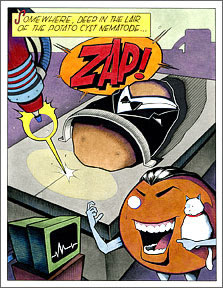Tuber Field Wars
Fierce ongoing potato field wars now battling potato cyst nematode
by MARLENE FRITZ
THE DEFINITIVE 4-color, 426-page Potato Production Systems book produced by
University of Idaho potato scientists and by UI CALS’ Educational Communications in 2003 devotes more than 30 percent of its pages to battling pests, diseases, nematodes, insects, and weeds.
For both scientist and potato grower, these fierce field wars never end. New variety development, integrated pest management, certified seeds, and much more are critical to win ever-present crop field wars.

Idaho’s latest challenge involves the potato cyst nematode (PCN).
University agricultural scientists are engaged in a multi-institutional project to defeat it and help eradicate it from eight eastern Idaho fields.
PCN’s detection in spring 2006 by University of Idaho nematologist Saad Hafez—its first confirmation in the U.S.—prompted a brisk shutdown of potato imports from Idaho by Canada, Mexico, and Korea. Japan reacted more strenuously, banning imports from the entire United States. Trade restrictions have since been eased but not eliminated.
Eradication is the goal
Because PCN can cause a high percentage of losses and because the regulated area of infested and closely associated fields is a relatively small and nearly contiguous 1,100 acres, the USDA Animal and Plant Health Inspection Service (APHIS) and the Idaho State Department of Agriculture have made eradication of this pest—not simply its management or control—their goal.
Eradication is also the goal of the $300,000 APHIS-funded project in which University of Idaho researchers are cooperating with colleagues from Washington State University and the USDA Agricultural Research Service in Prosser, Wash., and Ithaca, N.Y.
The project is being conducted within confines of the University of Idaho’s Agricultural Biotechnology Building—which offers laboratories, growth chambers, and greenhouses that are not only located far from Intermountain potato fields but that meet necessary pest containment standards. The eradication project encompasses:
- Evaluating the ability of PCN’s reproductive cysts to hatch on
potential weed hosts
- Testing traditional and non-traditional treatments
- Examining the ability of deeply placed PCN to survive fumigation
- Defining necessary techniques to rear PCN in the laboratory
- Developing molecular markers to accurately identify PCN
populations, and
- Discovering compounds in roots that stimulate PCN to hatch, with the aim of using those compounds to prompt hatching when and where the PCN can do no harm
CALS scientists participating in the eradication project include entomologist and department head James “Ding” Johnson, crop and weed science division chair Bob Zemetra, weed scientist Pamela Hutchinson, and support scientist Cassandra Bates.
They are also among a multi-institutional team that is requesting a $6 million federal appropriation to battle both this costly invader and potato virus Y, a disease that can attack virtually every susceptible potato in a field.
|